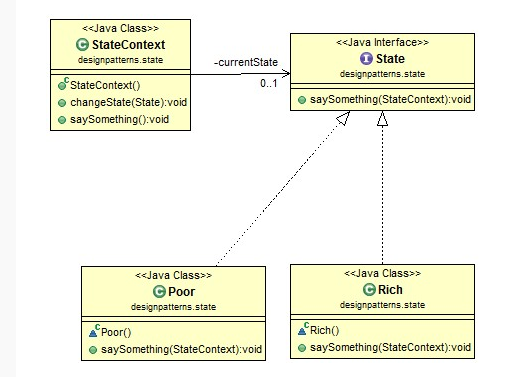更多内容参考 :
http://www.programcreek.com/2011/07/java-design-pattern-state/
state设计模式主要是为了在运行时改变状态。
下面是一个例子:
人们可以生活在不同的经济条件下,可以是富有 ,也可以是穷。两种状态可以相互转换。例子背后的想法是:
当人们穷的时候,他们更努力的 工作,当人们富有的时候,他们玩的多。他们做什么由他们的生活水平决定。他们的状态也可以由他们做
什么来改变。否则 ,这个社会就是不公平的。
State pattern class diagram
可以和strategy进行对比。

首先是state classes
package statepattern;
public interface State {
public void saySomething ( StateContext sc );
}
class Rich implements State{
public void saySomething(StateContext sc) {
System.out.println("i am rich and play a lot");
sc.changeState(new Poor()) ;
}
}
class Poor implements State{
public void saySomething(StateContext sc) {
System.out.println("i am poor and work a lot");
sc.changeState(new Rich()) ;
}
}
然后是stateContext
package statepattern;
public class StateContext {
private State currentState ;
public StateContext(){
currentState = new Poor() ;
}
public void changeState(State newState){
this.currentState = newState ;
}
public void saySomething (){
this.currentState.saySomething(this) ;
}
}
最后是测试代码
package statepattern;
public class TestMain {
public static void main(String [] args){
StateContext sc = new StateContext() ;
sc.saySomething() ;
sc.saySomething() ;
sc.saySomething();
sc.saySomething() ;
}
}